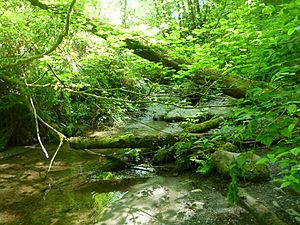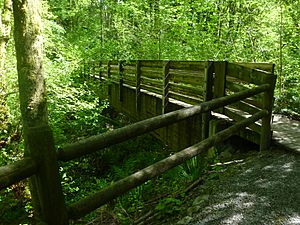Taylor Creek (Seattle) facts for kids
Taylor Creek is a cool stream, or small river, located in Seattle, Washington. It starts its journey in Lakeridge Park, specifically in a spot called Deadhorse Canyon. From there, it flows all the way to Lake Washington.
Contents
Discovering Taylor Creek
Taylor Creek is an important part of Seattle's natural world. It's one of the four largest creeks in the city. This means it plays a big role in the local environment.
Why is it Called Taylor Creek?
The creek got its name from a sawmill that used to be nearby. In the late 1880s, there was a sawmill owned by the Taylor family. It was located right where the creek flows into Lake Washington. That's how Taylor Creek got its name!
Helping Taylor Creek Thrive
For many years, people have been working hard to help Taylor Creek. This effort is called "restoration." It means bringing the creek back to a healthy, natural state.
- Starting the Work: Restoration efforts began way back in 1971.
- Volunteers to the Rescue: Many volunteers have given their time to help. They've planted thousands of native trees and plants. These are plants that naturally grow in the area.
- Cleaning Up: Volunteers have also removed tons of garbage from the creek and its banks. They've also gotten rid of "invasive plants." These are plants that don't belong and can harm the native ones.
- City Help: The city of Seattle has also helped a lot. They've removed things called culverts. These are like big pipes that can block fish from swimming freely. Improving trails also helps people enjoy and protect the creek.
Wildlife at Taylor Creek
Taylor Creek is a home for many different animals. If you visit, you might spot some interesting creatures!
- Mammals: Look out for raccoons and opossum. They are often seen near the water.
- Birds: Many kinds of birds also live around the creek. It's a great place for birdwatching.
In 2010, the city of Seattle started a new project. This project was specifically designed to make it easier for fish to travel up and down the creek. This helps fish like salmon return to their natural spawning grounds.



